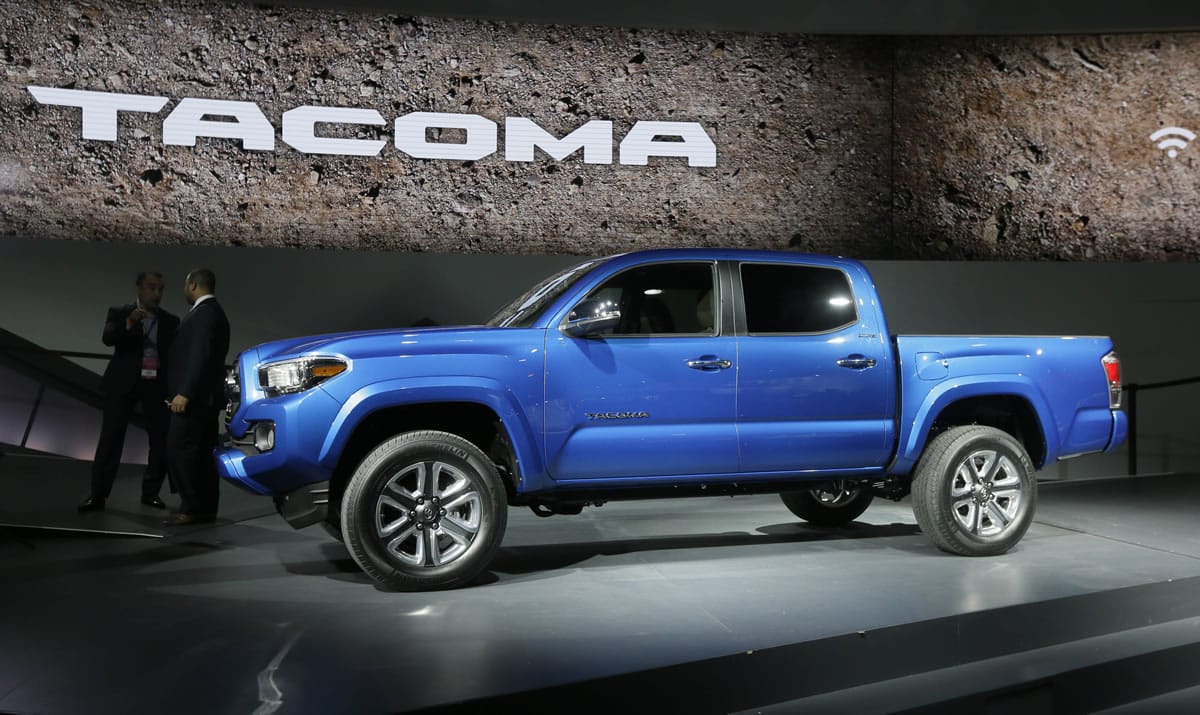DETROIT — Americans are about to have their pick from the broadest set of updated pickups ever, just as cheap gasoline rekindles their love affair with trucks.
Revamped versions of Toyota’s Tacoma and Nissan’s Titan are set to hit dealer lots in 2015, raising to nine the number of pickup models sold in the U.S. that will have been redesigned within the last three years. The breadth of fresh models is unprecedented in any period since Japan’s automakers began trying to crack the Detroit-dominated market in the 1990s.
The new pickups debuted Monday at the North American International Auto Show in Detroit will intensify the battle among automakers for a growing set of customers in an ever-lucrative segment of the U.S. market. As more Americans go back to pumping gas for less than $2 a gallon, Ford and General Motors lead truck manufacturers coming off their best year for deliveries since 2007.
“I don’t remember a time when all the trucks have been redone as close together,” Michelle Krebs, an analyst for AutoTrader.com, said in a telephone interview. “It’s true across the whole industry and it’s spreading to the truck business: new is not what it used to be. The bloom is off the rose a lot sooner.”
Automakers pursue U.S. pickup buyers because of the high number of purchasers and how much money those consumers are willing to spend. The market for $50,000-and-up trucks overshadows the set of buyers that Daimler’s Mercedes-Benz and BMW’s main brand draw for their pricey models, an analysis last month by TrueCar Inc. showed.
A confluence of economic and industry conditions contributed to the clustering of automakers’ pickup model redesigns into such a short period.
Automakers stretched the length of time their trucks went without major changes when rising gasoline prices shifted demand to buyers who needed them for work and their utility rather than for recreational or image reasons. The global recession forced manufacturers to tighten product-development budgets and push back updates even further.
In the small pickup market dominated by Toyota’s Tacoma, the Japanese manufacturer also could afford to wait because GM, Ford and Chrysler Group discontinued their competitive models in 2011 and 2012. GM returned to the market last year with the Chevrolet Colorado and GMC Canyon, and the former won Motor Trend magazine’s Truck of the Year Award.
“The competition is good to bring more awareness back to that compact or midsize segment now,” Mike Sweers, Toyota’s chief engineer for the Tacoma and Tundra pickups, said in an interview. “It’s bringing in some new customers.”
After having dominated the small-truck segment with 64 percent market share last year, Toyota is showing little alarm about Tacoma sales shrinking in the face of GM’s return. The Tacoma factory near Tijuana, Mexico, will become Toyota’s first North American plant to operate on three shifts starting in April, boosting production capacity by about 40 percent to 89,000 a year.
Contrary to Tacoma’s commanding position in small trucks, Nissan’s Titan is a bit player among full-size pickups. Within a year of its debut as a 2004 model, the truck’s share of the segment peaked at just 3.4 percent. Ford’s F-Series line outsold Titan 60-to-1 last year.
“The market performance of that segment has not mirrored cars in that the domestics have not really ceded share,” Tom Libby, an analyst with IHS Automotive, said by telephone. “In the ’80s, the Japanese really emerged in cars and the domestics lost their foundation. But in trucks, the domestics never really lost that foundation. There was never the dissatisfaction.”
The Titan’s showing in the market was so dismal that Chief Executive Officer Carlos Ghosn reached a deal in 2008 for Chrysler to build a replacement that it would rebadge as a Nissan. Those plans were scuttled when Fiat took control of the U.S. automaker the following year. Fiat and Chrysler completed their merger last year to form Fiat Chrysler Automobiles NV.
“That certainly didn’t do Nissan any favors,” Fred Diaz, senior vice president for Nissan’s U.S. sales, marketing and operations, said by telephone. “It put us behind the eight-ball and put us in a position where we knew it was going to take us much longer to get back into a marketplace that we needed to be in.”
Nissan will revamp Titan with more-pronounced styling than its decade-old and staid predecessor while also offering a 5-liter, V-8 turbo diesel engine supplied by Cummins Inc. that boosts performance.
At a press conference in Detroit Monday, Ghosn projected annual U.S. sales of the redesigned Titan to reach 100,000 within two years of its introduction in the fourth quarter. That would be about 5 percent of U.S. truck sales, a fivefold increase from today’s level.
“When you have a 1 percent market share on a segment like this, you just have nothing to lose,” Ghosn said. “You just come with your best product, and you go for it.”
Ghosn said he wants as many as half of Titan buyers to select the new Cummins diesel.
“The look of the truck is going to be quite appealing to a typical trucker and consumer,” said Diaz.



